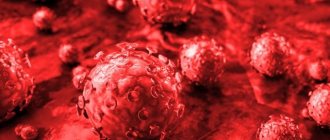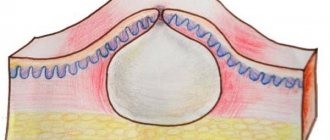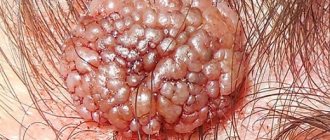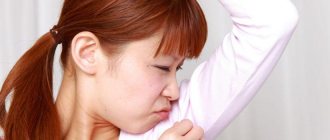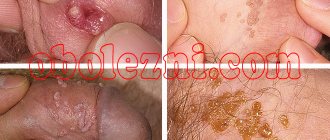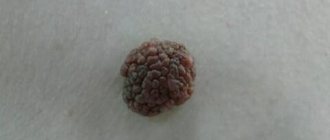The appearance of dense formations on the body that do not cause unpleasant symptoms is most often associated with infection with the papilloma virus. Such growths can occur at any age, regardless of the characteristics of the body.
The causes of warts and their removal in children is the most difficult and unpleasant process, since the child’s body is more sensitive to external irritants and not all methods can be used to eliminate such a tumor.
The correct approach to choosing a method for removing warts can prevent the occurrence of a large number of complications. Many experts do not recommend removing tumors yourself.
Before the removal process, it is necessary to diagnose and identify the cause of the tumor and the type to which it belongs, in order to prevent the formation of cancerous tumors.
Types of warts in children
In childhood, warts appear light-colored or flesh-colored, depending on the type of neoplasm and their location.
The following types of benign formations in children are distinguished:
- Common neoplasms are also often referred to as warts vulgaris. Most often they appear on the hands and elbows; in appearance they resemble a small formation that does not greatly exceed the level of the skin, light brown or flesh-colored. Appear as a result of contact with an infected object or person. The virus penetrates the layers of the epidermis in the presence of minor damage to the skin. They appear in single quantities or in groups. The surface of the formation is slightly rough; upon contact, the child does not experience strong unpleasant symptoms, especially if the wart is not damaged;
- Flat growths are a type of wart that occurs most often at an early age and occurs in childhood. Externally, they look like spots of a dense structure that practically do not differ from the surface of the skin. They are most often located in the face and neck area, however, they can appear in small quantities in any other part of the body. The surface of such a growth is most often flesh-colored with a smooth structure;
- Filiform warts – outwardly they look like pedunculated papules or an elongated formation. They are most often observed in the neck and face, mainly around the eyes. When pressed, they can contribute to the appearance of unpleasant symptoms of burning and itching.
Common warts
Flat warts
Filiform warts
The presence of growths that appear as a result of infection with papilloma infection most often signals disturbances in the functioning of the immune system.
Such growths are not dangerous to the child’s life if they do not have unpleasant signs. However, they can cause a feeling of shame and increased attention from peers, especially if the warts are located in the facial area.
Causes and symptoms
Infection with the virus occurs through any skin contact, but warts do not necessarily appear at the site of contact. Most often, the virus selects areas of the skin with injuries, cracks, or parts of the body that often come into contact with objects of public use (elbows, knees, feet, palms). Factors that make the body susceptible to the virus are also known:
- Dry skin on infected parts of the body;
- Scratches and injuries;
- Disturbances of the endocrine system;
- Reduced immunity;
- Sweaty feet and palms;
- Vegetative-vascular circulatory disorders, which are manifested by cyanosis of the extremities.
The presence of these factors can not only contribute to infection, but also complicate and delay the recovery process. In addition, some treatment methods (cauterization) can cause the opposite effect - the spread of warts to surrounding areas of the skin.
Human papillomavirus can be recognized in a child’s body by the following symptoms:
- The first symptoms may appear after infection in a period from 6 months to 3 years;
- Change in skin color around the affected area;
- Papillomas on the legs (in particular on the big toe) in the form of flat, smooth, small bumps;
- Painful warts appear on the heels - rough, rough.
Children 12-16 years old are more susceptible to this disease.
Diagnostics
Diagnosis of warts is carried out in a medical institution; the procedure most often consists of the following steps:
- Visual examination of the patient;
- , urine and stool tests
- PCR analysis , which will identify the papilloma virus;
- Taking a sample for histology - this type of analysis allows for timely identification of malignant formations.
If the formation is damaged or increases in size, additional types of tests may be prescribed, with the help of which a specialist determines the most appropriate method for removing the growth.
Features of location on the child’s leg
Growths rarely appear on the buttocks, thighs and lower legs. This is due to the small number of nerve endings in these areas. Flat forms of papillomas may appear on the knee or ankle joint, rarely prone to relapses or subsidiary formations. Genital warts occasionally appear in the popliteal fossa, most often in groups of 2 formations.
The most susceptible to wart infection due to its frequent trauma, hypothermia, excessive sweating, non-compliance with hygiene rules in children's groups (walking barefoot on tiles, using other people's flip-flops, etc.) is the foot.
There are several types of foot warts based on their location:
- On the back side.
- On the sole:
- in the heel area;
- on the arch of the foot;
- on the outer surface;
- in the tarsal region;
- On fingers:
- on the plantar surface;
- on the back surface;
- between your fingers.
Wart removal
The method of removing the formation is determined depending on the location of the growth. Experts say that many growths in childhood tend to disappear on their own after a certain time without the need for special procedures.
Mandatory removal of warts is necessary in cases where the formation quickly increases in size, causes discomfort, or produces a cloudy liquid when pressed.
A huge number of methods for removing warts are used; a qualified specialist will help you determine the correct method.
Laser removal
The technique is carried out using a special laser beam, which cuts off the growth, burning the skin cells, and reduces the likelihood of infection.
The advantages of this type of procedure:
- This removal method does not damage healthy cells , so there are no scars left on the skin;
- The method is safe and prevents infection;
- There are no unpleasant symptoms , the procedure is painless and suitable for removing formations of various sizes.
Disadvantages of the procedure:
- Burns may occur if the laser beam is used incorrectly;
- It is necessary to treat the removal site.
After completing the technique, it is recommended to treat the removal site for 7-10 days with special antiseptic solutions.
This removal method is suitable for absolutely all formations, however, no more than 2 warts are removed in one procedure.
The laser removal procedure is used from the age of 6 months as prescribed by a doctor. The cost of the procedure varies from 500 rubles per growth.
Cryodestruction
The essence of this method is to influence the formation of low temperatures, which freeze the cells and lead to the death of the papilloma virus. The procedure usually takes a few minutes.
After applying nitrogen to the formation, the growth darkens and a blister with cloudy contents appears; after several days, a crust forms on the blister, which falls off on its own.
Advantage of the procedure:
- There is no need to prepare for removal;
- The procedure takes a short time;
- Almost no traces remain;
- The risk of infection during removal is reduced to a minimum.
Disadvantages of the procedure:
- The procedure is painful;
- In rare cases, burns remain on the skin;
- Long recovery period;
- Several procedures are used to remove large growths.
After cryodestruction, it is necessary to avoid moisture in the affected area for several days.
After damage to the integrity of the bladder, it is necessary to treat the wound with a special antiseptic. It is prohibited to independently pierce and remove the crust from the affected area.
The use of the procedure is contraindicated for patients with an increased level of sensitivity, as well as in the presence of viral diseases that are accompanied by an increased level of body temperature.
The liquid nitrogen removal procedure is prescribed for patients over 3 years of age. The cost of the procedure starts from 200 rubles, depending on the number of growths.
Radio wave removal
The removal procedure is carried out using a radio knife, which removes infected cells. Thanks to radio waves, cells are completely removed and healthy areas are cauterized, which is necessary to prevent further infection.
Before starting the procedure, you must undergo blood and urine tests. The specialist also takes scrapings from the growth to determine the type of formation. It is recommended for children to use local anesthesia before starting the procedure.
Benefits of the procedure:
- Removal does not take much time;
- Adverse symptoms are rare;
- There are no scars or swelling;
- There are virtually no relapses.
Disadvantages of the procedure:
- Not suitable for large formations;
- High cost compared to other methods;
The technique is not used for formations that are located in the facial area.
After removal, a crust forms on the skin, which should be treated with an antiseptic for several days. On the first day, contact with water is prohibited.
Applicable for ages over 4 years. The cost of removal varies from 500 rubles depending on the size of the wart.
Electrocoagulation
During the procedure, the warts are cauterized using an electric current. For this, a special apparatus with a tip is used; the intensity of the electric current is determined depending on the size of the growth.
Advantages of the method:
- The procedure takes no more than 10-15 minutes;
- Can be used for any size of growth;
- After removing the growth, it is possible to diagnose the wart for the presence of malignant cells;
Disadvantages of the method:
- May leave marks after removal;
- There is a risk of the appearance of new cells infected with the virus;
- After removal, pigment spots may form on the skin;
- The recovery period lasts up to 10 days.
After exposure to electric current, dry skin particles appear in the area of the wart, which fall off on their own after a few days.
For several days, it is not recommended to contact with water and treat the skin with special antiseptic agents recommended by the doctor. It is necessary to prevent contact of sunlight and other types of external factors on the wound.
The procedure is not performed in the chest and face area. Allowed from the age of 6 years. The cost of the procedure is from 800 rubles .
Surgical removal
Surgical removal of warts is carried out only when absolutely necessary. The medical worker, using the necessary instrument, removes the growth along with the root.
After removal, the incision is treated with an antiseptic and stitches are applied.
Benefits of the procedure:
- Allows you to remove large formations;
- Prevents the formation of re-infection.
Disadvantages of the procedure:
- The procedure is painful and requires anesthesia;
- Scars and scars remain;
- Long recovery period after removal;
- Complications may develop in the form of suppuration and swelling.
- The procedure takes a long time.
After the procedure, the patient must treat the wound with an antiseptic for 5 days and wear a bandage. After which the child must visit a doctor to have the stitches removed.
This method of removing warts is used for all parts of the body. It is recommended to use this type of removal from the age of 6 years in case of urgent need.
The cost depends on the size of the growth and is determined individually for each child.
Drug treatment
To remove warts, you can use special medications, the action of which is aimed at eliminating the virus not only from the skin, but also inside the body.
Treatment of children with medications is carried out strictly as prescribed by the attending physician.
Many medicinal solutions that are aimed at removing warts contain chemical compounds, which can negatively affect the child’s health.
The drug for removing the papilloma virus is selected depending on the area where the benign type of formation is located.
Warts on hands and fingers
The appearance of warts on the hands is most often localized in the elbows, palms and fingers.
The most commonly used methods for removal are:
- Vitamin complexes , the action of which is aimed at enhancing the immune system against the papilloma virus;
- Drugs to enhance the protective functions of the immune system - prescribed to fight viruses inside the body and prevent its reappearance;
- Viferon suppositories - used before bedtime for 10 days. Suitable from the age of 1 year. Average cost 240 rubles ;
- Interferon - recommended to be used strictly as prescribed by a doctor, eliminates viral infection in the body and increases the protective processes of the immune system. Prescribed from the age of 4 years individually for each patient. Average cost 100 rubles ;
- External removal methods - the action is aimed at removing skin cells that are damaged by the virus: Salipod patch - allows you to fight small warts. The patch is applied once to the child’s clean skin and left until it peels off on its own. Allowed for use from the age of 6 years. Average cost 90 rubles ;
- Super Celandine - prescribed before bed, a small drop is applied to the wart and left for a few minutes, the duration of therapy is no more than 5 days. Use with caution for children over 7 years of age; it can cause burns and poisoning. Price 120 rubles .
Viferon candles
Interferon
Salipod patch
Super Celandine
When removing with externally applied preparations, you must carefully ensure that the substance does not get on the child’s mucous membranes. In such situations, you should rinse your mucous membranes with plenty of water and contact a medical facility.
Warts on the legs and feet
The skin on the legs is much rougher than on the body, so removing warts is much more difficult.
Warts can be localized both on the feet or soles, as well as on the heels (such warts are called plantar warts), and on the calves, knees and thighs of the legs.
The following medications are approved for the treatment of warts on the legs:
- Antiviral drugs – used to remove the virus from the child’s body: Cycloferon – used once a day for 5-6 days. Appointed from the age of 6 years. Average cost 230 rubles ;
- Echinacea tincture is a plant-based antiviral drug. Apply 5 drops along with any liquid. Duration up to 10 days. Allowed from the age of 3 years. Average cost 60 rubles ;
- Cryopharma – allows you to freeze the wart and eliminate infected cells. Apply once, after which a blister and crust will form in the area of application, which will fall off on its own after a short time. Appointed from the age of 5 years. Cost 450 rubles ;
Cycloferon
Echinacea tincture
Cryopharma
Duofilm
In addition to the use of pharmaceutical drugs, experts recommend keeping the child clean and ensuring that the body receives all the necessary vitamins.
Warts on the face
Removal of growths on the face is carried out with extreme caution. Experts do not recommend using solutions that contain chemical compounds in the facial area.
Recommended use:
- Viferon - available in the form of ointment and cream, has an antiviral effect on the epidermis, penetrates deeply into the layers and destroys the papilloma virus. Apply twice daily for up to 10 days. Recommended from the age of 1 year. Cost 230 rubles ;
- Oxolinic ointment - applied twice a day to the formation, prevents the reappearance of the virus on the skin. The duration of therapy is up to 10 days, acceptable for children over 2 years of age. Average cost 90 rubles ;
- Tea tree extract – refers to antiviral and antimicrobial substances. Use by spot application with a cotton swab in the morning and evening, avoid contact with the eye area. Duration of treatment is up to 15 days. Used in children over 3 years of age. The average cost is 40 rubles .
Viferon ointment
Oksolin
Tea tree extract
It is recommended to remove warts from sensitive skin on the face under the supervision of a physician. It is prohibited to independently use products to remove formations on a child’s face.
Are they dangerous?
The appearance of neoplasms often causes unjustified fears. Some types of HPV can actually cause cancer. However, warts on the legs are caused by completely different types of this virus.
Warts on a child's legs are absolutely not dangerous . You don’t have to touch them at all - as a rule, the immune system copes with this problem on its own.
But you don’t really want to wait for recovery when it hurts to step on your foot, especially if you have a chicken wart. Therefore, it is not a sin to help the child’s body get rid of unpleasant growths.
Traditional treatment recipes
Various traditional treatment recipes can be used to eliminate warts.
The most commonly used:
- Celandine - Apply the juice of a freshly harvested plant to the wart and apply a patch. The procedure should be repeated twice a day, for up to 5 days. Do not apply to the face area. Used from the age of 5 years;
- Garlic is a natural antiviral substance. Cut a clove of garlic in half and apply it to the growth, secure with a bandage or plaster, and leave overnight. Repeat the technique until the wart is completely eliminated. Appointed from the age of 2 years;
- Ice – helps freeze and eliminate infected cells. An ice cube should be wrapped in a piece of calico and applied to the wart for a few minutes. Repeat the procedure daily until the wart is completely eliminated. Not recommended for use in the eye area. Appointed from the age of 3 years;
- Potatoes – half a potato tuber must be grated on a fine grater and the resulting mixture should be applied to the wart and fixed with a band-aid. Can be used on all areas of the body. Perform daily before bed for up to 6 days. Can be used from 3 years of age;
- Lemon – apply a small piece of lemon to the growth and secure with a bandage or plaster. Performed once a day for no more than 5 days. Do not apply to the face area. Recommended from the age of 4 years.
To achieve results using traditional medicine, it is necessary to observe regularity.
Before starting therapy using traditional treatment, you must consult a doctor and check the child’s individual sensitivity to the components.
Prevention methods
To reduce the risk of warts, preventive methods should be followed:
- Eat plenty of vitamins and minerals;
- Treat scratches on the skin;
- Reduce contact with infected people;
- After visiting public places, wash your hands with antibacterial soap;
- In places with high humidity levels, use removable shoes;
- Spend more time outdoors.
Following simple prevention methods can reduce the likelihood of skin growths forming.
If a wart has formed, you should not try to remove the growth on the child’s body yourself; it is better to seek help from specialists to carry out the necessary type of diagnosis.
How does HPV infection occur?
As we noted above, the main cause of warts is infection with the human papillomavirus. You can become infected with the virus in various ways.
It is transmitted sexually, through the use of personal hygiene items, and through contact with contaminated skin. The chance of catching the virus increases when visiting a bathhouse or swimming pool. In such cases, increased humidity and heat provoke the spread of the virus.
Provoking factors for the activation of the virus are:
- decreased immunity;
- hormonal changes in the body (including pregnancy);
- chronic diseases;
- Unhealthy Lifestyle;
- promiscuity.
Important!
Oncogenic types of HPV are transmitted overwhelmingly through sexual contact. Therefore, infection with dangerous strains occurs no earlier than 16–20 years of age.
Reviews
Reviews of drugs for the treatment of warts in children:
Review of Dufilm
Review of Echinacea Tincture
Review of Interferon
Review of Cryopharm
Review of Oxolinic ointment
Review of the Salipod patch
Review of Viferon (candles)
Review of Super Cleaner
Review of Cycloferon
Review of Viferon (ointment)

